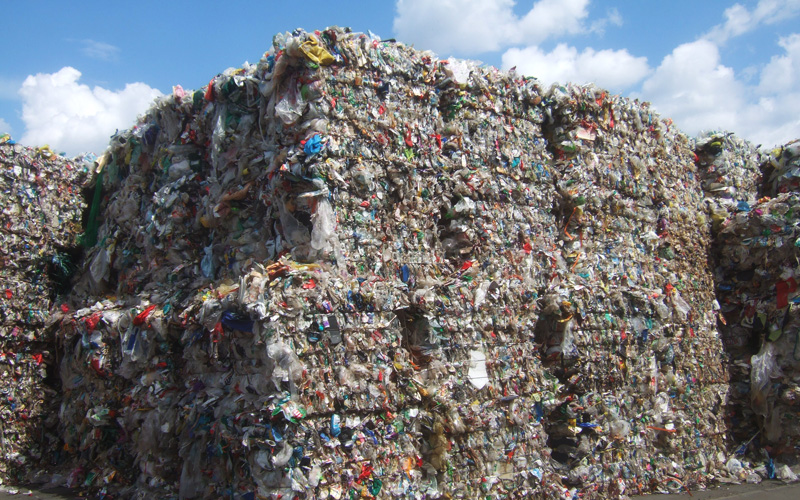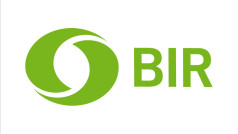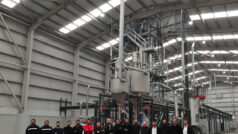There are now major supply shortages across the recycled polyethylene terephthalate (R-PET), recycled high density polyethylene (R-HDPE), recycled polypropylene (R-PP) and recycled polyvinyl chloride (R-PVC) chains.
Multiple players across these markets expect current shortages to last throughout 2021, and potentially across 2022.
Waste bales – either from post-consumer or post-industrial origin – are the feedstock for the recycling industry, and low availability is adding pressure throughout the recycling supply chain.
For R-PP, for example, flake and pellet players have had to limit operating rates by as much as 40% in recent months due to a lack of bale availability.
There are multiple factors in the current shortages, and which differ slightly from market to market, including the onboarding of projects delayed by the coronavirus pandemic, logistic and workforce disruption due to COVID-19, changes to waste input mixes, and substitution of virgin material owing to shortages in the first half of 2021.
The common trend across all markets, though, is the lack of sufficient collection and sorting capacity.
Expansions in collection and sorting capacity have not kept pace with demand created by growing sustainability pressure on Fast Moving Consumer Goods Firms, ambitious brand targets, and the ongoing consumer and regulatory pressure against single-use plastic.
Across most of Europe waste collection is the responsibility of local authorities, and investment in collection systems has been limited since the global financial crash in 2008.
As an example of how sharp the gap can be, in Europe, at present, there is around 600,000-700,000 tonnes/year of post-consumer rigid PP input.
This would be sufficient to replace around just 5.5% of Europe virgin plastic packaging consumption, based on ICIS Supply & Demand database figures, assuming that every tonne were used by the packaging sector with no wastage.
For R-HDPE, there is around 700,000-800,000 tonnes/year of post-consumer rigid input, and a similar figure for R-LDPE.
This would be enough to replace 11% and 15% of virgin plastic packaging, respectively under those same conditions.
However, wastage rates (the amount of material lost during production due to contamination or mechanical losses) are typically from 25-50%, packaging does not have a 100% share of the market, and many applications can only use natural material. Natural material comprises around 10% of bale input.
This suggests that current collection capacity could replace less than 1% of current virgin polyolefins plastic packaging consumption.
Brands have increasingly begun to announce ambitious recycling content targets, which are typically for 25-50% recycled content, but can be as high as 100% recycled content.
As a result of ongoing single bale shortages, downstream players are increasingly looking to create joint ventures with waste management firms and to backwards integrate over expectations that bale shortages could become endemic, largely the result of rising demand from the packaging sector.
Given the current lack of bale capacity some polyolefins players are expecting investment in selection systems for mixed-plastic bales, and an increase in usage of mixed-plastic feedstocks.
These are the same feedstocks that many chemical recyclers in Europe typically seek to use, potentially placing the two industries in direct opposition.
At present, many calculations on the economic feasibility of chemical recycling plants are predicated on the assumption that waste management companies will pay to have waste plastic bales taken away, or that partially sorted bales will remain at low cost.
This is currently common because the alternative would be to pay gate fees for incineration or landfill, and as long as the money paid to chemical recyclers is below gate fee costs, waste managers are prepared to do it.
As this material increasingly becomes desirable or usable for the mechanical recycling chain, though, competition is likely to intensify and making material sold at negative values increasingly less likely.
Traditionally, September would be the time across the major recycled polymer markets when bale availability is at its highest.
For R-PET, this is because its major input source is used plastic drinks bottles, more of which are consumed when temperatures are higher. It typically takes several weeks for the used bottles to make their way back into the chain, and so September is when extra volumes from the summer become apparent.
For recycled polyolefins, convertors and recyclers typically shutdown during July and August for routine maintenance, and lower consumption typically lengthens the bale market.
In 2021, however, strong demand from the packaging sector has meant that the summer months have done little to rebalance the market.
That bale supply is so tight in September is causing concern across the recycled polymer chains, but particularly for R-PET.
Traditionally, R-PET convertors and recyclers build stock in the summer months when temperatures are high and more material is typically entering the waste stream to offset lower volumes entering the chain in colder months.
Underlying demand for the R-PET flake sector has strengthened in 2021 due to additional capacity coming onstream and an increasing number of players captively producing from flake through to pre-form, and increased interest in flake material from the bottle-to-bottle sector.
Increased demand is being stimulated by intensifying sustainability commitments from the packaging sector, and ongoing consumer and regulatory pressure against single use plastics.
R-PET flake consumption has increased by as much as 60% compared with 2019 levels – 2020 demand was negatively impacted by the pandemic – according to market estimates.
This has placed upward pressure on bale prices throughout 2021. Bale prices are the largest variable cost for the recycling industry, and this has increased production costs significantly during 2021. Rising electricity costs have also had an impact because of the higher cost of washing material.
“There is a risk that the escalation in recycled polymer prices and inability to increase supply due to structural constraints will begin to challenge some users in their ambitions to attain high recycled content levels and for some to use recycled content at even a minimum level,” said Helen McGeough, Senior Analyst, Plastics Recycling, at ICIS.
“The drive of the end markets has not been mirrored by developments and investment upstream in collection and sorting, without focus on these fundamentals the industry can expect high costs and supply limitations through 2022.”
Demand, meanwhile, shows now sign of slowing. With plastic packaging taxes due to come into effect in Italy, Spain and the UK in 2022, and brands approaching their 2025 content commitments, and other sectors such as automotive and fibre becoming increasingly interested in sustainability, underlying consumption is expected to continue to grow.
ICIS has been highlighting collection and sorting capacity shortages for several years, never have they been more apparent than in 2021.










